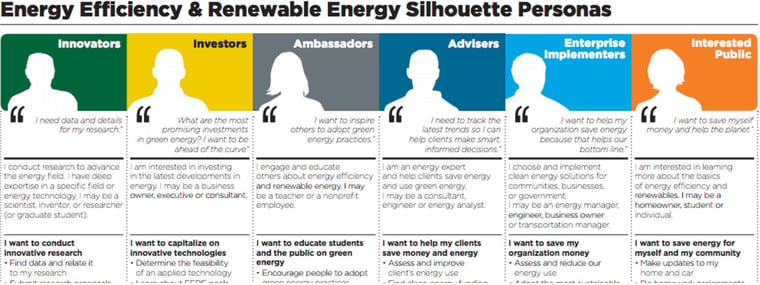
Powerful Personas Boost Renewable Energy Marketing

 Would you rather market your renewable energy services to Customer A or Customer B?
Would you rather market your renewable energy services to Customer A or Customer B?
Customer A: Lives in Los Angeles. Drives a Prius. Eats a vegetarian diet. Is 30 to 50 years old.
Customer B: Lives anywhere in the United States. Drives a variety of vehicles. Eats a diverse diet. Is 53 years old. Has an advanced degree. Is frustrated by information that doesn’t entirely answer his or her questions. Is influenced by renewable energy industry trade publications and websites. His or her knowledge of energy efficiency and renewable energy is 7.2 out of 10. He or she has a desire to inspire others to learn about energy efficiency and renewable energy.
Naturally, Customer B would be easier to market to, because, instead of just a small amount of superficial information about them, you have an arsenal of genuine insight into what makes them tick—including their beliefs, attitudes, challenges and fears.
With this deep insight, you can better understand their lifestyle, write content that speaks directly to their motivations and drivers, and reach out to them in places where they already are.
That’s the power of buyer personas. And it’s why a growing number of companies are making the effort to create detailed buyer personas of their ideal customers.
According to the Buyer Persona Institute, 44 percent of companies are already using buyer personas to market to their customers and 29 percent are working toward creating them.
Buyer Personas Power Up Marketing
So what are buyer personas exactly? According to expert Tony Zambito, they are “research-based archetypal (modeled) representations of who buyers are, what they are trying to accomplish, what goals drive their behavior, how they think, how they buy, and why they make buying decisions.”
In essence, personas are three-dimensional fictional representations of buyers’ demographics, behaviors and occupation based on real data. They are composite pictures of the people who are most likely to purchase a company’s products and services. Their purpose is to put marketers in the shoes of their customers so they can more powerfully market to them.
Several industry studies have uncovered the power of buyer personas. For example, a survey conducted by Cintell found a strong correlation between the use of qualitative research and the effectiveness of buyer personas. Almost 82 percent of companies that exceeded their revenue goals had conducted qualitative research to create their buyer personas. On the other hand, 70 percent of the companies that missed their revenue goals had not conducted qualitative research to create buyer personas.
The study also unearthed the following insights:
- High-performing organizations are 3.8 times more likely to have an accountable internal resource dedicated to buyer personas.
- Companies that exceeded leads and revenue goals were 7.4 times as likely to have updated their personas in the last six months than those that missed their targets.
- High-performing companies were 2.3 times as likely to research the drivers and motivations of their buyers.
A study conducted by ITMSA found that, because personas encapsulate buyer needs, priorities and drivers, they are fundamental to closing the gap between long-standing marketing and sales approaches and current buying behaviors. Further, personas have the potential not only to improve the impact of marketing’s efforts, but also to demonstrate the value marketing brings to the rest of the business.
Renewable Energy Buyer Persona Examples
The power of buyer personas has already reached the alternative energy industry. Many organizations are creating them to better understand and communicate to their potential consumers.
The U.S. Office of Energy Efficiency and Renewable Energy (EERE) has created six detailed buyer personas to assist companies in this sector in their marketing efforts.

As an example, these are the data points for the Enterprise Implementer EERE buyer persona:
- Location—Majority live in the United States
- Age—Late 40s to early 50s
- Gender—Predominantly male
- Advanced degrees—35 percent own their own business
- Motivation—Saving energy, and therefore money
- Job—Makes decisions on energy usage and implementation for communities, organizations, commercial businesses or government agencies
- Influences—The economy and pressure to do more with less, company management, government regulations, trade organization, and more
- Informational Needs—Primarily nontechnical
- Frustrations—Information that is biased, unreliable or incomplete
- Top Candidate for—Renewable energy programs (biomass, geothermal, solar, wind, water)
- Wants—To save organization money.
Other organizations have also conducted general research to better understand today’s emerging renewable energy customers. For example, the National Renewable Energy Laboratory (NREL) conducted a survey that discovered the following insights:
- 80 percent of consumers have expressed that they care about the use of renewable energy (although this diminishes in a challenging economic environment).
- Consumers primarily associate the purchase of renewable energy with environmental benefits.
- Consumers are more focused on the economic benefits as the principal factor for choosing to use or invest in renewable energy.
- Consumers’ awareness of renewable energy options remains relatively low.
6 Steps for Creating Powerful Buyer Personas
How can your company create meaningful buyer personas that will help you reach your potential customers more powerfully?
There are several ways to create buyer personas. The process includes gathering data in multiple ways from multiple sources, including:
- Current consumer databases
- One-on-one interviews
- Structured surveys
- Trade show and event interaction
- Website contact forms
- Industry research
The data you’ll use to flesh out your personas are demographic data (age, gender, income, ZIP code, occupation, education, and location); behavioral data (attitudes, habits, values, interests and opinions); occupational data (job, function, duties, influencers and goals).
These six steps will help you build buyer personas:
1. Search your current customer databases for insights.
2. Conduct phone and in-person interviews. Talking to your existing customers can provide valuable information into their buying habits, what motivates them and the words they use to describe your product or service. You can also go back and ask your respondents to elaborate, getting details not available through surveys.
3. Conduct industry research online. Look for insight on your buyer personas that is already available online, such as the research conducted by EERE.
4. Conduct customer surveys. Either online or off, use open-ended questions to gather insight into how your customers frame their motivations and needs. The goal is to get inside your customer’s heads to make sure your personas are based on what real people think, not just what you think they think. Look for behavioral drivers, obstacles to purchasing, and mindset insights. For example, ask:
- When did you realize you needed a product or service like ours?
- What problem does our product or service solve in your life?
- What doubts or hesitations did you have before buying?
5. Conduct Web surveys. Whenever you offer something free on your website, such as a webinar or eBook, ask specific questions in the form. The questions to ask depend on your overall goal. Do you want to understand what messages resonate with consumers? Or do you want to understand what potential sources of friction are keeping customers from buying? Experiment with your questions to find what gets the most responses and the responses with the most insights.
6. Distill your research into actionable insights. Segment your buyer personas based on the commonalities you uncover. Then begin filling out detailed buyer persona documents to share with the marketing team, such as HubSpot’s buyer persona template.
It’s easy to build entire marketing campaigns around companies’ preconceived beliefs about consumers, or try to force the companies’ agenda down consumers’ throats. But these approaches are likely to fail.
Taking the time to understand consumers at a deeper level by building buyer personas will help companies sidestep tone-deaf marketing and create campaigns that resonate profoundly.
Challenging emerging markets like alternative energy need a deep understanding of their potential buyers’ attitudes, desires and biases. When they gain this insight, they improve their opportunity to launch powerful marketing campaigns that grab consumers’ attention, inspire them to learn more and nurture them down the sales funnel.



